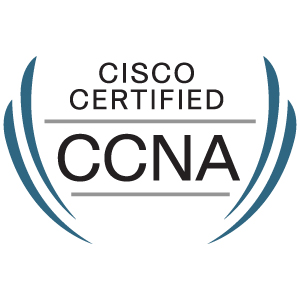Cisco Certified Network Associate – CCNA Online / Classroom Training
Cisco Certified Network Associate (CCNA) Routing and Switching is a certification program for entry-level network engineers that helps maximize your investment in foundational networking knowledge and increase the value of your employer’s network. The CCNA Routing and Switching validates the ability to install, configure, operate, and troubleshoot medium-size routed and switched networks.
A majority of the professional networking world consider the CCNA to be the de facto Network Engineering exam that qualifies a user to operate a small to medium business network. Furthermore, the CCNA opens doors for new exams, such as the CCNP (Cisco Certified Network Professional) and CCDP (Cisco Certified Design Professional) certifications.
Overall, the CCNA has several subjects that it covers in detail, but the primary subjects of concern are Routing and Switching, including but not limited to the use of: IP, IGRP, Serial, Frame Relay, IP RIP, VLANs, RIP, Ethernet, and access lists. After attaining the CCNA, the exam is valid for three years before it must be recertified.
Who should attend:
Students who are looking for a job in network field.
Prerequisites:
Basic Networking Knowledge. Hands on Experience with any operating system
CCNA Syllabus:
Introduction to Networking
OSI Model
Networking Fundamentals and Networking Media
Components of a LAN
Cabling LANs and WANs
Ethernet Fundamentals
IPADDRESSING
TCP/IP Protocol Suite
IPv4 Address Classes
Addressing Fundamentals
IPV4 SERVICES
Domain Name System
Internet Control Message Protocol (ICMP)
Transmission Control Protocol (TCP)
User Datagram Protocol (UDP)
Differences between TCP & UDP
SUBNETTING
Classful vs. Classless Addressing
Subnet Calculation Process
VLSM
CIDR
Summarization
ROUTER
Introduction to Router
Configuring a Router
Managing Cisco IOS Software
IOS backup & Recovery
Password Recovery of router
ROUTING BASICS
Introduction to Routing Protocols
Static Routing
Default Routing
Dynamic Routing
IP ROUTING PRINCIPLES
IP Routing Fundamentals
Link State Protocol
Administrative Distance
ROUTING PROTOCOLS
IGRP
Differences between RIPv1 & RIPv2
Configuring RIP
OSPF
OSPF Fundamentals
Configuring OSPF
OSPF Route Selection
OSPF Route Preferences
EIGRP
EIGRP Fundamentals
Configuring EIGRP
EIGRP Route Selection
EIGRP Troubleshooting
Access Control Lists (ACLs)
Access-List Fundamentals
Configuring ACL
Access-List Processing
Wildcard Masks
Standard IP Access-Lists
Extended IP Access-Lists
Troubleshooting Access-Lists
NETWORK ADDRESS TRANSLATION (NAT)
Introduction to NAT
NAT Fundamentals
Configuring static NAT
Configuring Dynamic NAT
NAT Troubleshooting
Port Address Translation
Introduction to PAT
Configuring PAT
FRAME RELAY
Frame-Relay Fundamentals
Implementing Frame-Relay
Frame-Relay with ARP
Frame-Relay Serial Interface
SWITCHING
Introduction to Switching
Switch Architecture
Configuring Cisco switches
Running debug commands
VLANS
Introduction to VLAN Technology
VLAN Principles
Creating VLANs
VLAN Trunking
Configuring Inter-VLAN Routing
Spanning-Tree protocol
Spanning-Tree Basics
Configuring Spanning-tree
Spanning-Tree Convergence
Spanning-Tree Enhancements
Spanning-Tree Troubleshooting
Introduction to IPV6
IPv6 Fundamentals
IPv6 Routing
Configuring EIGRP for IPv6
Completing IPv6 Configuration
WLAN Technology
Wireless Fundamentals
Wireless LAN Components
Wireless LAN Types
Wireless LAN Operation
Wireless LAN Security
Configuring wireless router
Security Device Manager (SDM)
Introduction to SDM
Prerequisites of SDM
Configuring SDM
Troubleshooting SDM
Download Soft Copy Request Course Details

